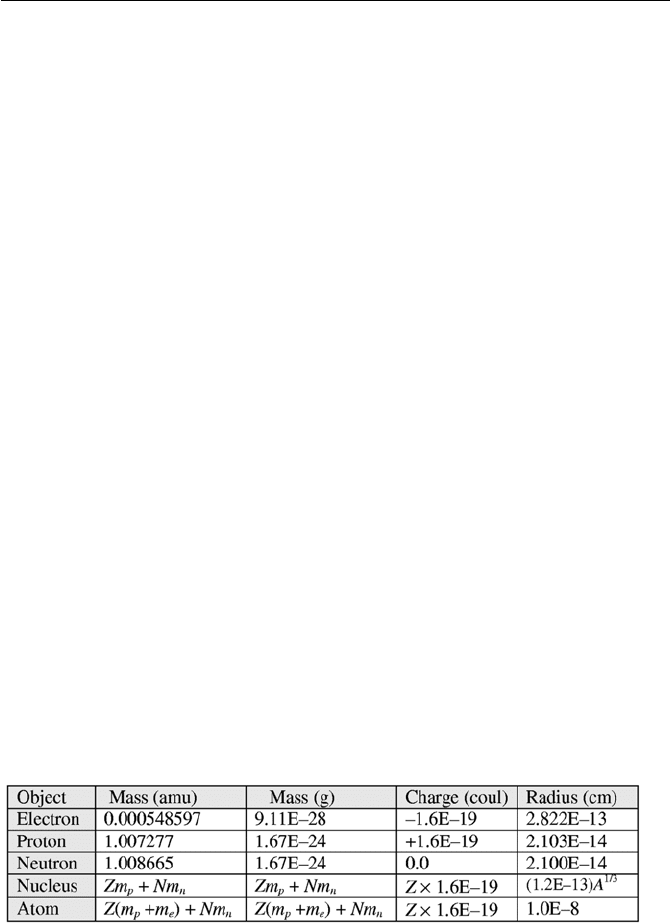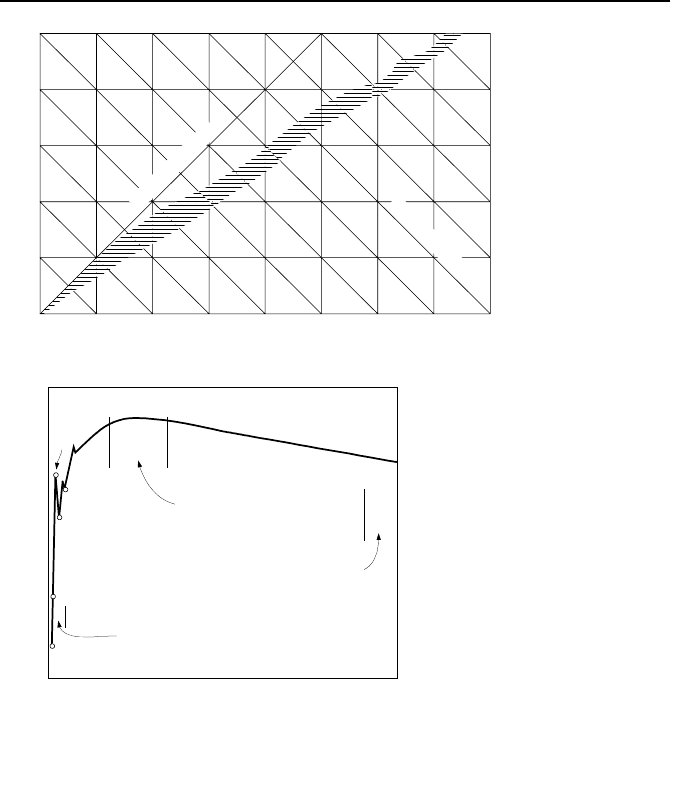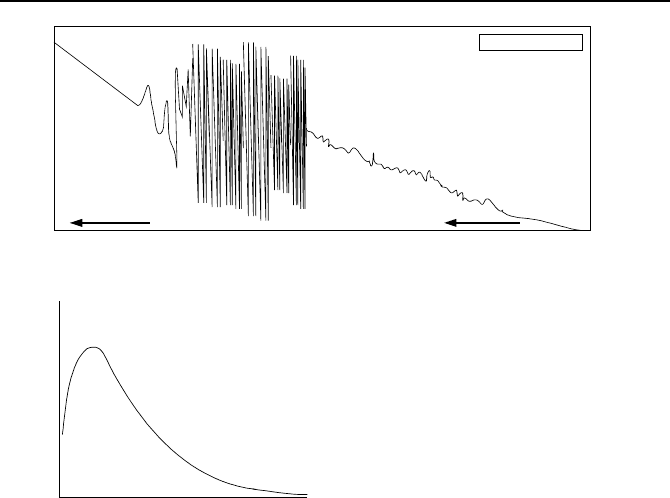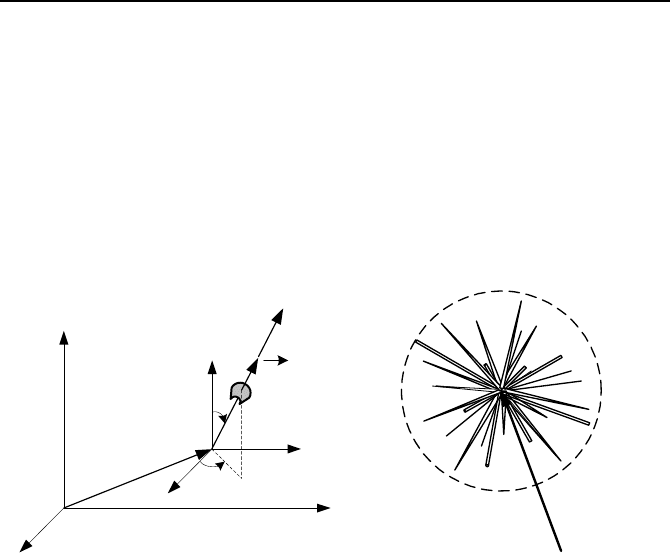Massoud M. Engineering Thermofluids: Thermodynamics, Fluid Mechanics, and Heat Transfer
Подождите немного. Документ загружается.


842 VIe. Applications: Nuclear Heat Generation
electrons that each orbit, or shell, can possess. In chemical reactions, electrons of
the last shell, which is not filled to capacity, bond with the shells of other atoms to
produce a molecule. In this reaction, the nucleus remains intact. In nuclear reac-
tions, the nucleus itself is affected.
Nucleon is referred to a particle that exists in the nucleus. Thus protons and
neutrons are nucleons.
Nuclide refers to a specific atom or nucleus. If a nuclide is not stable, it is re-
ferred to as a radionuclide.
Atomic number (Z) represents the number of protons in an atom. If N is the
number of neutrons, then the mass number (A) is equal to the total number of neu-
trons and protons, A = N + Z. We generally show elements as
E
A
Z
. For example,
natural uranium is shown as
U
238
92
. There are elements for which we can find
various mass numbers. Atoms of these elements have the same number of protons
but a different number of neutrons. These are known as isotopes. For example,
naturally occurring uranium ore has 99.28% atoms of
U
238
92
, 0.714% atoms of
U
235
92
, and 0.006% atoms of U
234
92
. Thus U-233, U-234, U-235 and U-238 are
isotopes of uranium. The effect of isotopes on mass number is shown in Figure
VIe.1.1(a). We may enhance the number of atoms in an isotope in the naturally
occurring substance; this process is referred to as enrichment.
Atomic mass unit (amu) is equal to the one-twelfth of the mass of carbon 12.
Since one mole of
12
6
C has 6.023E23 atoms and weighs 12 gram, then 1 amu =
(1/12) × (12/6.023E23) = 1.66E–24 gram. On this basis, m
proton
= 1.007277 amu,
m
neutron
= 1.008665 amu, and m
electron
= 0.000548597 amu as summarized in Ta-
ble VIe.1.1. Based on Einstein’s equation, the energy equivalent with 1 amu is E
= mc
2
= (1.66E–27 kg)(3E8 m/s)
2
= 1.49E–10 J. Since 1 MeV = 1.602E–13 J,
then 1 amu = 931.5 MeV.
Table VIe.1.1. Approximate classical characteristics of atoms and particles
Atom density, N is the number of the atoms of an element per unit volume
(#/m
3
). Atom density is given by N =
ρ
N
A
/M. Atom density is generally a func-
tion of space and time,
),( trNN
K
= .
Mass defect is defined as the difference in measured mass between the con-
glomerate mass of a coalesced nucleus and the sum of the masses of the individual

1. Definition of Some Nuclear Engineering Terms 843
constituent particles of that nucleus. The mass defect for element E
A
Z
, for exam-
ple, is found as ∆m = Z(m
proton
) + N(m
neutron
) – (M
E
– Zm
electron
).
Binding energy (B.E.) of a nucleus is the energy-equivalent of the mass defect
of that nucleus (B.E. = ∆mc
2
). The binding energy may be thought of as the en-
ergy that would be required to break the nucleus into its individual constituents or
as the amount of energy that would be released upon an instantaneous coalescence
of all individual constituents to form the nucleus.
Example VIe.1.1. Find the mass defect and the binding energy per nucleon for
Beryllium,
9
4
Be . The mass of this element is given as 9.01219 amu.
Solution: The mass defect is found as:
∆m = 4 × 1.007277 + 5 × 1.008665 – (9.01219 – 4 × 0.000549) = 0.062439 amu
The equivalent energy is found as:
E = mc
2
= (0.062439 × 1.66E–27 kg)(3E8 m/s)
2
= 9.328E–12 J = 58.2 MeV.
The binding energy per nucleon is found as:
58.2/9 = 6.5 MeV/nucleon.
Binding energy per nucleon, Figure VIe.1.1(b) is a minimum for hydrogen and
reaches a maximum of about 9 MeV per nucleon for iron. As mass number in-
creases beyond 60, binding energy per nucleon keeps dropping. The slope of the
curve is an indication of relative stability and potential sources for energy release.
For example, for such heavy elements as Uranium and Plutonium, the binding en-
ergy drops to about 7.5 MeV/nucleon. If the atom of such materials split, energy
is released and more stable nuclei appear.
Neutron-nucleus interactions are of two types. Consider bombardment of a
target material with a beam of neutrons. Depending on the energy and the direc-
tion of the neutrons as well as the atoms of the target, we may have an interaction.
If an interaction occurs, it results in the neutrons being scattered from the nucleus
or absorbed by the nucleus.
Scattering is one of two outcomes resulting from interaction between a target
nucleus and the bombarding neutron. If the total kinetic energy of the neutron and
the nucleus before and after the scattering event remains the same, the event is re-
ferred to as elastic scattering. Otherwise, the interaction is known as inelastic
scattering. For low neutron energies in elastic scattering, the passing neutron is
bounced due to the force exerted by the nucleus, hence the process is referred to as
potential scattering. However, for higher neutron energies, the neutron and nu-
cleus may combine to form a compound nucleus from which a neutron emerges.
For inelastic scattering to occur, the energy of the neutron must exceed the mini-
mum energy required for a compound nucleus to form.

844 VIe. Applications: Nuclear Heat Generation
20
40 60 80 100
1400
160
120
0
20
40
60
100
80
M
a
s
s
n
u
m
b
e
r
,
A
Neutron number, N
Atomic number, Z
2
4
0
2
2
0
2
0
0
1
8
0
1
6
0
1
4
0
1
2
0
1
0
0
8
0
6
0
4
0
2
0
T
h
e
z
o
n
e
o
f
N
=
Z
(a)
20 40 60 80 100 1400
160
120
0
2
4
6
10
8
Mass number, A
Binding energy per nucleon (MeV)
180 200 220 240
Helium
Hydrogen
Litium
Boron
Uranium
Fe
Suitable
for fission
Plutonium
Suitable
for fussion
Stable
Nuclei
He
4
2
He
3
2
( )
Mg
Mn
(b)
Figure VIe.1.1. (a) Effect of isotopes on mass number and (b) Binding energy per nucleon
Absorption is the second outcome in a neutron-nucleus interaction. Absorp-
tion in turn may lead to several types of interactions. The absorption of a neutron
by the nucleus places the resulting compound nucleus is an excited state. The
compound nucleus may then break up, leading to fission, or it may de-excite itself
by emitting energetic radiation such as alpha (
α
), gamma (
γ
), neutron (n), or pro-
tons (p). Although the excited state of a nucleus can be as short as 1E–14 seconds,
it is considered a well-defined state compared with the approximately 1E–22 sec-
onds it takes for a neutron to travel across the nucleus.
Resonance. Application of the wave or quantum mechanic to the atomic nu-
cleus shows that the internal energy of a nucleus is quantized (see the solution to
Equation VIIb.1.32). If a neutron has a sufficient amount of K.E. for the creation

1. Definition of Some Nuclear Engineering Terms 845
of a compound nucleus then the neutron and the nucleus are said to be in reso-
nance.
Microscopic cross section
σ
i
, represents probability of occurrence of a given
type of interaction between an incident neutron and the target nucleus of the me-
dium through which the neutron travels. In this case, the subscripted variable, i,
represents the type of interaction, whereby the relative probability of occurrence
of a scattering reaction would be represented as
σ
s
(
σ
a
for absorption and
σ
f
for
fission). This property, which represents probabilities of certain types of interac-
tion, is specific to the target nucleus type (as it is a property) and is also dependent
upon incident neutron energy and type of interaction. This probability is generally
represented in units of area, cm
2
, or barns (b) where 1 barn = 1.0E–24 cm
2
.
Macroscopic cross section, Σ
i
is the probability of interaction of type i per unit
length (1/cm) of neutron travel. Thus, the chance of interaction with an atom per
unit distance traveled is
σ
and for N atoms is Σ
i
= N
σ
i
.
Resonance cross section refers to the range of neuron energy of 1 eV to 1E5
eV where for many isotopes the absorption cross section of the target nucleus dis-
plays extreme variations in magnitude as shown in Figure VIe.1.2(a). The reso-
nance cross section, indicating a high probability of interaction, occurs when the
energy quantized or the excited state of the compound nucleus matches the sum-
mation of the neutron K.E. and the compound nucleus binding energy.
Fission event. Figure VIe.1.1 shows that, following the stable region, binding
energy decreases with increasing number of neutrons. This implies that if we
break up heavy nuclei such as uranium, we would end up with two nuclei having
mass numbers of about one-half of the original nucleus hence being more stable.
This is indeed the case, as the breaking up, referred to as fission, results in lighter
and more stable nuclei with respect to fission. The appearance of a fission prod-
ucts is a probabilistic event. For example, the fission of uranium-235 may result
in excess of 200 different isotopes of 35 different elements. Examples for fission
of a Uranium-235 nucleus include the appearance of Zr, Te, Kr, and Ba:
n2TeZrUn
1
0
137
52
97
40
235
92
1
0
++→+
n3BaKrUn
1
0
142
56
91
36
235
92
1
0
++→+
It must be emphasized that the fission products are generally highly radioactive
and thus hazardous.
The above reactions indicate that, in a sustained interaction leading to fission,
between 2 to 3 neutrons emerge for each neutron that is absorbed to cause fission
in U-235. The number of neutrons emerging in a fission is represented by v.
These newly emerged neutrons have a spectrum of energy as shown in Fig-
ure VIe.1.2(b) and mathematically described as:
EeE
E
29.2sinh453.0)(
036.1−
=
χ

846 VIe. Applications: Nuclear Heat Generation
1E-2 1E0
1E-1
1E1
1E2 1E3 1E4 1E5 1E6
1E0
1E1
1E2
1E3
Energy (eV)
Cross section (barns)
Fast
neutrons
Thermal
neutrons
1/V region
Uranium-235
Perilous journey for neutron thermalization
Resonance region
(a)
0.1
0.2
0.3
123456
Energy (MeV)
χ(E), Normalized flux, (MeV)
-1
Thermal neutron induced
fission in uranium-235
(b)
Figure VIe.1.2. U-235 (a) Fission cross-section and (b) prompt fission neutron spectrum
where E is in MeV. While some newly emerged neutrons have energies as low as
a fraction of MeV and a few up to 17 MeV, the most probable energy is found as
0.73 MeV and the average energy as 1.98 MeV. The U-235 isotope has a large
fission cross section for slow neutrons, (i.e., neutrons that have energy in the range
of 0.025 eV). Hence, we must use some means of slowing down neutrons to such
low energies. However, the journey for neutrons from about 2 MeV to about
0.025 eV is quite perilous. This is because the U-235 cross section for fission is
highly energy dependent (Figure VIe.1.2(a)). Thus, there is a high probability that
the neutron, before being slowed down is captured in the isotope, especially in the
resonance region, hence not leading to fission. In the low energy range, referred
to as the thermal region, the nucleus cross-section is proportional with the inverse
square root of energy, known as the 1/V region.
Fissile, fissionable, and fertile isotopes. A fissile material is an isotope that
would fission upon the absorption of a neutron of essentially no kinetic energy. In
other words, simply the binding energy of that last neutron in the compound sys-
tem is enough to overcome the critical energy required for fission to occur. This
type of isotope proves to be the most useful for producing the neutron chain reac-
tion necessary to produce power with a thermal pressurized water reactor. Fissible
isotopes include
233
U,
236
U,
239
Pu, and
241
Pu. Plutonium-239 is found in abun-

1. Definition of Some Nuclear Engineering Terms 847
dance in spent fuel rods and can be recovered in reprocessing facilities. During
normal operation of a nuclear reactor, plutonium-239 is produced inside the fuel
rod such that towards the end of a fuel cycle, it is one of the major contributors (up
to 50%) of the power produced by the reactor. Fissionable materials are isotopes
that, like fissile materials, fission, but only with fast or energetic neutrons (ener-
gies higher than 2 MeV for U-238). An important fissionable isotope is the natu-
rally occurring U-238. The contribution of this isotope to the power level of a
thermal reactor is about 5%. Other fissionable isotopes are
232
Th and Pu-240.
Fertile materials are isotopes that do not fission but produce fissile materials as
a result of an interaction with neutrons. An example of a fertile isotope is
Th
232
90
:
1 232 233 233 233
090 90 91 92
nThThPa U
ββ
−−
+→→+→+
where
β
–
refers to beta-decay. The most important fertile isotope is uranium-238
resulting in the fissile isotope plutonium-239.
Since there are isotopes that are suited for fission if exposed to fast neutrons
and similarly isotopes suited for fission by slow (or thermal) neutrons, there are
also two types of reactors, fast and thermal. However, there are many more nu-
clear reactors based on thermal fission than based on fast fission.
Moderator is used to slow down the newly born fast neutrons in thermal reac-
tors. The moderator in thermal reactors generally has a dual role as it is also used
as a coolant. Water (H
2
O) is used in “light water reactors” and heavy water
(D
2
O), using deuterium instead of hydrogen, in “heavy water reactors”. The latter
reactor is of Canadian design and is known as the Canada Deuterium Uranium or
CANDU reactor, for short. Since a neutron loses most of its energy in scattering
events with light nuclei, a moderator should be a substance made of light nuclei
with low absorption and a high scattering cross section. Properties of widely used
moderators are listed in Table VIe.1.2, where D is the diffusion coefficient and
a
Σ is the macroscopic absorption cross sections.
Table VIe.1.2. Properties of some moderators (at 20 C) for thermal neutrons (Lamarsh)
Moderator Density (g/cm
3
) D (cm)
Σ
a
(1/cm)
Water (H
2
O) 1.00 0.16 1.97E–2
Heavy Water (D
2
O) 1.00 0.87 9.3E–5
Beryllium (Be) 1.85 0.50 1.04E–3
Graphite (C) 1.60 0.84 2.4E–4
1.2. Definitions Pertinent to Neutrons
Neutron density, n(
r
K
, E, Ω
K
, t) as shown in Figure VIe.1.3(a) is the number
of neutrons that at time t are at location x, y, z in volume dV, of energy E about dE
and travelling in the direction of
Ω
x
, Ω
y
, and Ω
z
(or Ω
r
, Ω
θ
, and Ω
φ
) in d Ω
K
(the
solid angle is shown in Figure IVd.5.1). If, for example, we want to find the num-

848 VIe. Applications: Nuclear Heat Generation
ber of neutrons having all ranges of energy and travelling in all directions, we in-
tegrate over energy and solid angle
*
:
³
(
)
³
Ω
∞
ΩΩ=
K
KK
KK
ddEtErntrn
0
),,,(),( VIe.1.1
While n(
r
K
, Ω
K
, E, t) has units of s
–1
cm
–3
eV
–1
sr
–1
, n(
r
K
,t) has units of neutrons/s
cm
3
.
Neutron velocity, V(E) is the length per unit time traveled by the neutrons,
(cm/s). Neutron velocities may range from 8,000 to 80,000,000 km/h. The newly
born neutrons due to fission are very energetic (average energy is about 2 MeV
but some may emerge with energies up to 20 MeV). Such neutrons lose their en-
ergy due to collision with the moderator nuclei. The loss of energy would eventu-
ally result in neutrons coming to thermal equilibrium with their surrounding me-
dium. This is why the slowed down neutrons are referred to as being thermalized.
Energy of neutrons in a neutron population can be approximately obtained from
the Maxwell-Boltzmann distribution (see Problem 4). Using the Maxwellian dis-
tribution, we can find the most probable velocity in terms of neutron temperature
as V = (2țT/m)
1/2
where
κ
is the Boltzmann constant,
κ
= R
u
/N
A
= 8.314/6.023E23
= 1.38E–23 J/K. Thus, neutrons at room temperature of 20 C have a velocity of V
= (2
× 1.38E-23 × [20 + 273.16/(1.008665 × 1.66E-27)]
1/2
§ 2200 m/s. The ki-
netic energy at this velocity is:
()()
(
)
2 2
2
. . / 2 0.5 1.008665 1.66E 27 / 1.602E 13 (2200)
5.226E 15 0.0253 V
KE mV
V
ªº
¬¼
==× ×− −
=−=
Neutron angular flux,
φ
(
r
K
, E, Ω
K
, t)dEd Ω
K
is the number of neutrons at loca-
tion r, energy (E) about dE and traveling at time t through a unit area perpendicu-
lar to
Ω
K
, in the differential solid angle d Ω
K
in the direction of Ω
K
. As shown in
Figure VIe.1.3(a),
Ω
K
is the unit vector of the neutron velocity vector, hence,
Ω=
KK
VV . To find the integrated steady state neutron flux, we integrate the steady
state angular flux over all solid angles to obtain:
()
³
ΩΩ=
Ω
KK
KK
dErEr ,,),(
φφ
VIe.1.2
For the special case of isotropic emission of neutrons, where neutrons are distrib-
uted uniformly over the surface area of a sphere having a radius of unity, the angu-
lar flux is related to the integrated flux through:
π
φ
φ
4
),(
),,(
Er
Er
K
K
K
=Ω
VIe.1.3
*
Another way of representing n(
r
K
, E, Ω
K
, t) is to write
d
6
n/dxdydzdEd Ω
K
dt = d
7
n/dxdydzdE(sin
ϕ
d
θ
d
ϕ
)dt

1. Definition of Some Nuclear Engineering Terms 849
The integrated flux is shown in Figure VIe.1.3(b). To relate neutron flux to the
number density of the neutrons, we may treat neutrons as a fluid and use the simi-
larity between neutron flux (
φ
), neutron density (n), and neutron velocity (V) with
mass flux (G), density (
ρ
) and flow velocity (V) per Equation IIa.5.3, (G =
ρ
V).
Thus, for neutron flux we find:
φ
(
r
K
, E) = n(
r
K
, E)V(E) VIe.1.4
If the integrated flux over all directions is also integrated over all energies, we find
neutron flux
φ
(
r
K
, t) or the steady state flux
φ
(
r
K
). This is referred to as the one-
speed neutron flux.
Ω
ϕ
θ
V
z
x
y
u
y
u
x
u
z
r
r
(a) (b)
Figure VIe.1.3. (a) Depiction of position and direction of a neutron. (b) Integrated flux
over all directions at position
r
K
(Ott).
Angular current density is a vector defined by the following relation
(, , ,) (, , ,)
J
rE t rE t
φ
Ω= ΩΩ
KKK
K
KK
, hence, it has an absolute value equal to the angu-
lar flux. Thus
(, , ,)
J
rE tdEdSdΩΩ
JJG
KK
K
K
represents the rate of neutrons at location
r
K
, passing at time t through differential area dS, with an energy (E) in dE and in
the direction of
Ω
K
in d Ω
K
.
Neutron current density or simply neutron current is obtained by the integra-
tion of the angular current density over all possible directions:
()
³
ΩΩ=
Ω
KK
K
K
K
K
dtErJtErJ ,,,),,(
VIe.1.5
If we integrate the neutron current density over all ranges of energy we obtain
the neutron current as
),( trJ
K
K
. The neutron current, being a vector, is instrumen-
tal in describing the leakage of neutron, into or out of a region.

850 VIe. Applications: Nuclear Heat Generation
Rate of neutron interaction, is obtained by multiplying the neutron flux by the
macroscopic cross section of the nucleus for a specific outcome. Thus R
i
=
φ
Σ
i
(neutron/s·cm
2
) × (atoms/cm) = interaction/s·cm
3
.
Rate of heat generation
q
′′′
(W/cm
3
) is found from the rate of interaction. If
we consider the interaction of type i as that leads to fission, then i = f and R
f
=
φ
Σ
fr
, where subscript fr stands for fission in the fuel rod. If the energy produced
per fission is E
R
, then the total power produced per unit volume is given by:
q
′′′
= E
R
φ
fr
Σ VIe.1.6
The energy produced per fission, E
R
is about 200 MeV (1 eV = 1.6E–19 joules
hence E
R
= 3.2E–11 J). When the nucleus of a heavy element undergoes fission,
most of the resulting energy is due to the kinetic energy of the fission fragments as
shown in Table VIe.1.2. Note that the deposited energy is E
d
= 90% E
R
=
180 MeV.
Table VIe.1.2 Approximate distribution and deposition of fission energy (El-Wakil)
Type Process Percent of
total energy
Energy
deposition
Kinetic energy of fission fragments 80.5 Fuel material
Kinetic energy of the emergent fast
neutrons
2.5 Moderator
Fission
(prompt)
γ Energy associated with fission
2.5 Fuel & structure
Kinetic energy of delayed neutrons 0.02 Moderator
β
–
-decay energy of fission products
3.0 Fuel material
Neutrinos from
β
–
5.0 Nonrecoverable
Fission
(delayed)
γ-decay of fission products
3.0 Fuel & structure
Capture
β
–
and γ-decay energy of (n, γ) product
3.5 Fuel & structure
Total 100
Example VIe.1.2. Find the prompt energy of U-235 fission resulting in the ap-
pearance of Xe and Sr:
()
()
γ
7n2SrXeSrXenU
1
0
95
38
139
54
*96
38
*140
54
1
0
235
92
+++→+→+
Solution: The prompt energy related to the mass defect is found from:
() ( ) ()
235 139 95 2
92 54 38
[U Xe Sr2]
pn n
E
MmM M mc=+−−−
= [235.043923 + 1.008665 – 138.918787 – 94.919358 – 2(1.008665)]
Thus E
p
= 0.197113 amu = 0.197113 × 931.5 MeV/amu= 183.61 MeV. This in-
cludes 5.2 MeV kinetic energy of the two prompt neutrons and 6.7 MeV energy of
the emerging gamma rays.

1. Definition of Some Nuclear Engineering Terms 851
The six factor formula. Earlier we discussed that the emerging fast neutrons
from the fission of U-235 have a perilous journey from the fast to the thermal re-
gion before being used for the next fission cycle. Aside from being absorbed in
the nucleus (fuel) without causing fission, they may leak out of our control volume
or may be absorbed by elements other than the fuel, such as the reactor structure
(Table VIe.3.1). To formulate this verbal discussion in mathematical terms, we
consider two cases of infinite and finite media. The infinite medium consists of
fuel, structure, and neutrons. In such a medium, no neutron can be lost to leakage.
However, for the finite medium case, we do lose neutrons to leakage. Such leak-
age is due to scattering out of the region of interest. To keep track of the neutron
inventory in each cycle, we define k, the multiplication factor, as the ratio of the
number of neutrons in the new cycle to the number of neutrons in the previous cy-
cle. We represent this ratio by k
∞
for the infinite and by k
eff
for the finite medium.
If we divide the energy spectrum to fast and thermal, we may lose neutrons to
leakage in both energy regions. The relation between the ratios is:
k
eff
= k
∞
P
FNL
P
TNL
were P
FNL
is the probability that a fast neutron not leak out and P
TNL
is the prob-
ability that a thermal neutron does not leak out. Having taken care of the leakage
term for now, we begin to focus on k
∞
. By definition, in an infinite medium, the
ratio of neutrons in the present cycle to that of the previous cycle is:
³
³
³
³
³
³
³
³
∞
∞
∞
∞
∞
Σ
Σ
=
Σ
Σ
=
0
0
0
0
),(),(V
),(),(V
),(),(V
),(),(V
k
ErErd
ErErvd
ErErd
ErErvd
a
medium
f
fuel
a
medium
f
medium
KK
KK
KK
KK
φ
φ
φ
φ
where we changed the numerator to an integral over the fuel region, as there is no
fission anywhere else in the medium. We further break down the above ratio by
introducing terms in the numerator and denominator.
³
³
³
³
³
³
³
³
³
³
³
³
³
³
³
³
∞
∞
∞
Σ
Σ
×
Σ
Σ
×
Σ
Σ
×
Σ
Σ
=
0
0
0
0
0
0
0
0
),(),(V
),(),(V
),(),(V
),(),(V
),(),(V
),(),(V
),(),(V
),(),(V
k
ErErd
ErErd
ErErd
ErErd
ErErd
ErErvd
ErErvd
ErErvd
a
medium
E
a
medium
E
a
medium
E
a
fuel
E
a
fuel
E
f
fuel
E
f
fuel
f
fuel
T
T
T
T
T
T
KK
KK
KK
KK
KK
KK
KK
KK
φ
φ
φ
φ
φ
φ
φ
φ
VIe.1.7
where E
T
≅ 1 eV is a cutoff energy separating the thermal region from the slowing
down region. The first ratio represents the neutron production rate as a result of
both fast and thermal fission to the neutron production rate due only to thermal
fission. This ratio is shown by
ε
and referred to as the fast fission factor:
³
³
³
³
T
E
f
fuel
f
fuel
ErErvd
ErErvd
0
0
),(),(V
),(),(V
fissionthermalinproducedneutronsofNo.
fission thermalandfast inproducedneutronsofNo.
KK
K
K
φ
φ
ε
Σ
Σ
==
∞
